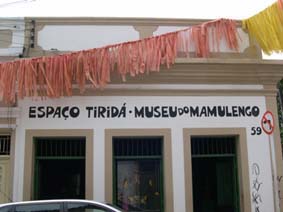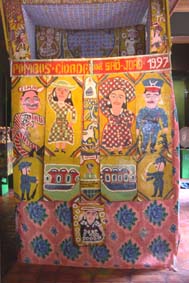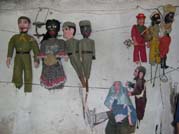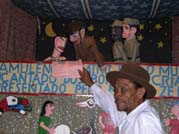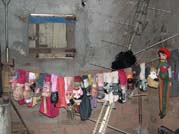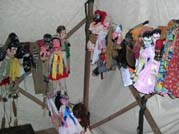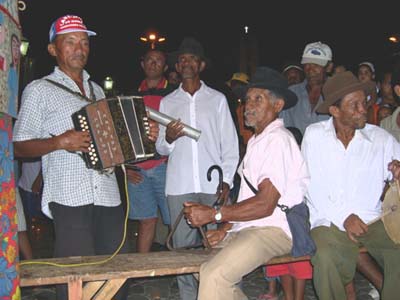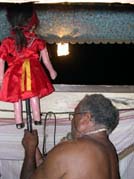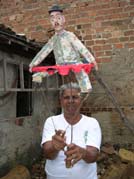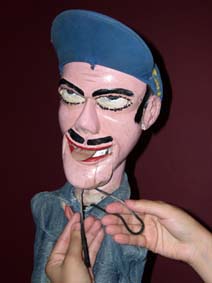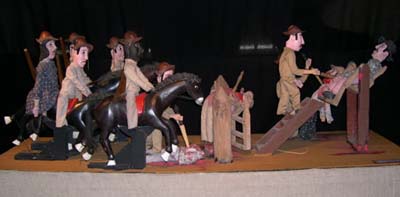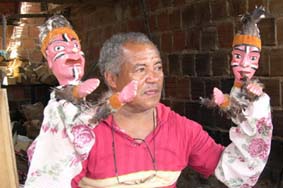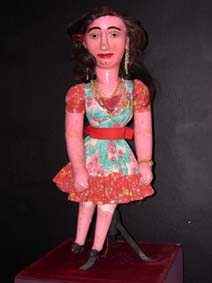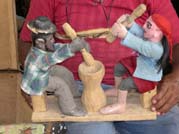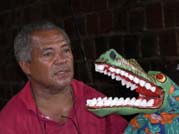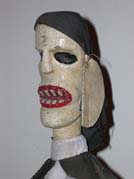Mamulengo, the Theater of Laughter
by Elisabeth den Otter
In February-March 2004 I travelled to Brazil, and spent some time in Olinda (Pernambuco) with Izabela Brochado, who teaches at the University of Brasília and is a puppeteer as well. She was into her third year doing research and doing fieldwork in the state of Pernambuco. We discussed her research, and I read some of the relevant literature. We visited the Mamulengo Museum in Olinda and took pictures of many puppets exhibited there. And, of course, Izabela took me to meet puppeteers and see their performances.
Mamulengo is a form of popular puppet theater which is found in the Northeast of Brazil, especially in the state of Pernambuco. The economy of this rural region is based mostly on sugarcane and cattle, as well as tourism. The actual population is a result of two centuries of miscegenation: indians (the original inhabitants); descendants of European colonizers, mostly of Portuguese origin; and blacks ('imported' slaves from Africa). The puppet theater reflects the colonial situation of a hundred years ago: those in power (landowners, military, clergy) exploit and repress the common people. Laughter is one of the ways to deal with this struggle of the oppressed against those in power. Because of its subversive aspect, it is also political theater.
Mamulengo was on the verge of extinction, but was revived thanks to the efforts of people like Fernando Augusto Gonçalves and Magda Modesto. The Mamulengo Museum, Espaço Tiridá (named after the popular character of Professor Tiridá), in Olinda has a large collection of puppets, some of which are shown in this article. The driving force behind it is Fernando Augusto Gonçalves, who also runs the puppet theater 'Só-Riso' (Only Laughter) in Olinda, close to the museum. The puppets represent human beings, animals and imaginary beings. The humans are caricatures of the syncretism so typical of Brazil. The performance consists of short sketches ('passagens'): romantic and heroic episodes taken from the 'literatura do cordel' (booklets with popular stories and songs, illustrated with woodcuts, that the seller hangs on a cord) and from oral tradition. Human ambition and weakness are exposed and ridiculed. Ginu (Januário de Oliveira) wrote some well known pieces for mamulengo, and created the character of Professor Tiridá. The dramatic action is alternated with song and dance. Performances take place in the open air, in a booth which is about 200 cm high and 150 cm deep. The front is often decorated with painted wooden plaques or a piece of cloth that show the names of the theater and the puppeteer, as well as characters from the plays.
The human comedy
A group of puppeteers usually consists of a puppeteer (the 'mestre'), his assistant (the 'contra-mestre'), and a person who functions as an intermediary between the puppets and the public (the 'Mateus'). They are accompanied by a group of musicians. The puppeteers speak, using different voices for each puppet, and sing popular songs. They often improvise, especially when interacting with the public. They earn little money with their shows, and generally have other jobs to support themselves and their families. Lately, official institutions such as the town halls have been offering much-needed support.
I had the pleasure of meeting two puppeteers and seeing them in action: Zé Lopes (José Lopes da Silva Filho) of Gloria do Goitá, and João Galego of Carpina . Both were assisted by their wives, and accompanied by musicians.
The group of Zé Lopes is called 'Mamulengo Teatro Riso' (Laughter Theater). He makes and repairs his own puppets; he also makes puppets for sale, because he does not earn enough money as a puppeteer. On the photographs he is seen repairing Quitéria, one of the leading females, in his workshop. Other puppets hang on ropes on the wall, waiting to be chosen for a performance. Those that will be used are put in a box, together with the musical instruments, ready to be transported. He is assisted by his wife and accompanied by a group of musicians playing accordion (Bilim), triangle (Seu Luiz) and drum (Zé Salo); the latter also plays the role of Mateus. Zé Lopes was photographed in his home/workshop and filmed during a performance on the square of Gloria do Goitá, in February 2004.
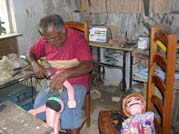
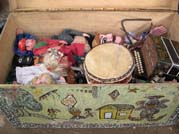
The group of João Galego is called ' Nova Geracão' (New Generation). He is assisted by his wife Marlene and musicians playing accordion, triangle, and drum. He makes his own puppets, from 'mulungu' wood, which can be seen on the photograph, behind the box with puppets. (The term 'mamulengo' may be derived from 'mulungu'.) João Galego was photographed in his home/workshop and during a performance in Carpina, in February 2004.
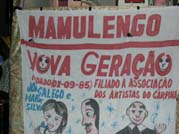
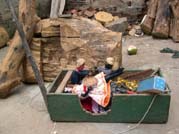
Musicians accompany the performance, playing the accordion, triangle and drum; often, someone from the public shakes a tube-shaped metal instrument ('ganzá'). They play 'forró', the popular regional genre.
The puppeteers sing as well. In the following video fragment, Marlene sings the song accompanying the sketch of the Laborer and his Wife, about the necessity (but also the joy) to work in order to earn one's daily bread.
The public takes an active role during the performances: some approach the booth and enter into dialogue with the puppets or offer them food or drink. On the following video fragment a man receives an egg laid by a bird (a scene which is also depicted on the front of the booth).
Heroes and villains
The puppets are made from wood and cloth; they are usually made by the puppeteers themselves. There are hand puppets and rod puppets. The hand puppets have a wooden head and wooden hands and are manipulated by three fingers: thumb and little finger for the arms and the index for the head. The rod puppets are held by a rod which is attached between the legs of the puppet, usually representing a woman. Rigid puppets such as policemen and soldiers are held by one of the legs, which makes them a kind of rod puppet. The clown has three rods: one to hold the body, and two for each leg. Some characters, like Simão, have a mouth that can be opened, a tongue that can stick out, and eyes that can be moved; this is done by means of elastic bands and strings.
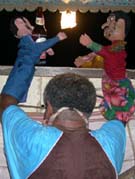
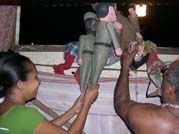
A special form of puppetry is the so-called 'casa de farinha', a puppet theater with moving parts where entire scenes are shown. An example of this is a scene that shows the bandit Lampião invading an estate; it was made by the famous mestre Saúba (whose son Bibiú is also a well known puppet maker).
Indians (Caboclos) are represented in a naive manner, with feathers and bows-and-arrows.
Popular heroes are Simão and Quitéria; the latter is married to Mané Pacaru, a wealthy landowner, and together they have a daughter who is always getting into trouble with men. They represent the Portuguese aspect of Brazilian culture. Simão, the anti-hero who belongs to the working class, is always trying to seduce the women by dancing with them (and sometimes doing more than that...).
The following video fragments show João Galego and Marlene with landowner Mané Pacaru, his wife Quitéria and Simão. The latter is interested in their daughter and interrogated by them: Is he married? does he drink or smoke? (The answer, of course, is 'no' on all counts...) The song that Marlene sings is about the famous bandit Lampião, defender of the oppressed.
Blacks are mostly shown in the form of working people: a farmer, a woman selling 'cuzcuz' (Chica da Fuba), people pounding grain (Pisapilão), etc. The farmer Caroquinha generally opens the show, and Benedito, the black cowboy, is an anti-hero like Simão. Puppets showing working activities are not known in European puppetry, which could indicate origins or influences from Africa. (See under 'Mali' on this website; the farmer and women pounding grain exist in the shape of rod puppets that sit on the back of a large 'animal'.)
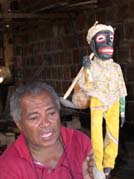
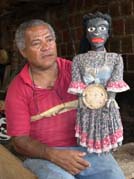
Izabela Brochado is particularly interested the roles women play in the sketches. She points out the different types such as the young unmarried woman looking for adventure, the mother who tries to keep her safe, and the lascivious old widow. Women's sexuality has to be controlled, and the daughter's honor has to be preserved so that she can be married off. The daughter usually does not speak but only emits interjections, whereas the mother defends her daughters honor through spoken interventions. The old widow may be seen as a witch, due to her big sexual appetite (even with the Devil himself), but also as a wise character. The identity of the females exists mostly in relation to men; they are literally rag dolls, without a will of their own. They do little else but dance and twirl around, and this is reflected in their construction: they are mounted on a rod (so that the puppeteer does not have to touch any part of her body!), and are not manipulated by strings or other mechanisms. However, some women are more active: they talk and move their arms; examples of this are the Mother and Chica da Fuba, the black cuzcuz seller.
Animals, such as the ox, play an important role in this rural society. Snakes (that look more like crocodiles...) enter into fights with humans.
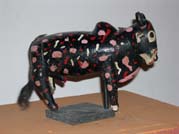
Imaginary beings such as Devils, Vampires, and Papa Figo (who eats the liver of disobedient children) are also part of the performance.
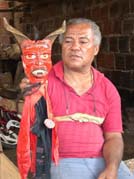
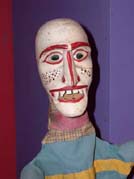
In the last video fragment Zé Lopes, via Colotilde and Quitéria, says goodbye. 'Thank you. We hope you enjoyed the show!'
The actual puppet theater is typically Brazilian: the cultures of the indians, the blacks and the white colonizers merged into mamulengo. This syncretic form of popular culture is dynamic and full of humor, malice and sensuality. Anti-heroes like Simão and Benedito, the black cowboy, are irreverent and obscene, mocking those in power. It is not particularly refined, often overdone, and full of caricatures. It serves as entertainment, but is also an outlet of feelings and criticism. By dramatizing situations and conflicts of his world, the puppeteer -through his wooden puppets- represents his own people who, through this cathartic spectacle, takes revenge for the humiliation it suffers from the hands of those in power.
With thanks to Zé Lopes, João Galego, Izabela Brochado, and the Mamulengo Museum.
Literature:
Borba Filho, H.: 'Fisionomia e Espíritu do Mamulengo', (2nd ed.).
Rio de Janeiro, 1987.Brochado, Izabela: 'Representações femininas no teatro de mamulengo'.
In: 'Teatro de Marionetas. Tradição e modernidade', Christine Zurbach (ed.), Evora, 2002, pp.227-235.Gonçalves dos Santos, Fernando Augusto: 'Mamulengo, um Povo em Forma de Bonecos'.
Rio de Janeiro, 1979.Modesto, Magda: 'A Arte do Tïtere no Brasil'.
In: 'Teatro de Marionetas. Tradição e modernidade', Christine Zurbach (ed.), Evora, 2002, pp.199-205.Pimentel, Altimar de Alencar: 'O Mundo Mágico de João Redondo'.
Rio de Janeiro, 1971.More about puppetry
